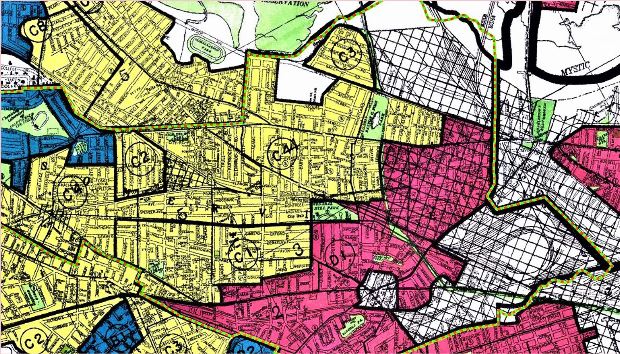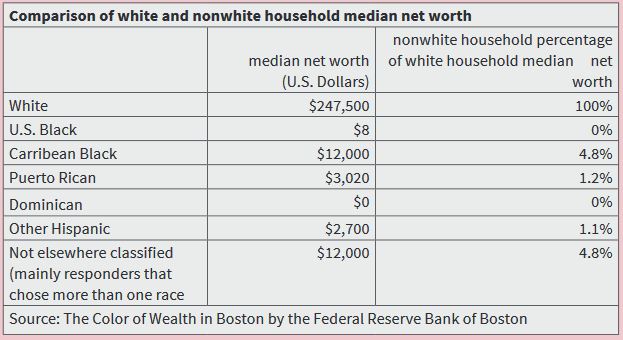REDLINING & RACIAL WEALTH GAP
Historically, “residential security” maps served as guidelines for real estate professionals and loan officers. These maps would color neighborhoods red that had immigrants or people of color living there, deeming the neighborhoods too risky for mortgages and insurance. At the same time, the real estate industry would also not let immigrants or people of color move into white neighborhoods since it would affect the perceived risk for the residents that lived there already. When the GI Bill of 1944 was implemented, the “redlining” of minority neighborhoods meant that as white veterans were able to buy houses at record rates using their government benefits and insurance, Black veterans were largely unable to access these same resources they had earned.Redlining was outlawed in 1968, but the effect of these kinds of racist policies have a huge impact on Americans today. In 2015, The Color of Wealth in Boston was published by the Federal Reserve Bank of Boston with Duke University and the New School. It compares the value of assets held by white and non-white households – white households have more than 14x more in total assets than the next demographic cohort. The gap in homeownership among races is a component of this wealth gap.This is only one simple example, but it demonstrates that not everyone has had access to the same opportunities historically. These unfair policies have effects that last for generations. Today, we must consider equity and how to account for these generational injustices in order to ensure meaningful opportunity for success for all of our community members.

DISPLACEMENT
Concerns about displacement are paramount for many SomerVision Committee members and are a common thread through much of the feedback received during this planning process. As the cost of living rises, individuals and families are forced to move away. This challenge is a central component to the Housing topic chapter, which talks about the need for improved data about the housing problem as well as a multi-faceted strategy to pursue housing affordability and prevent additional displacement.However, worries about displacement and the rising cost of living appear throughout nearly all of the topics the Committee explored. Youth and Education heard from students and parents that the phantom of displacement brings stress to children’s lives, whether because they may need to move or because their friends do. Community and Governance identifies displacement as the most immediate threat to the sense of community in Somerville and points out that these departures erode the fabric of connections that make the city stronger. Access to affordable and reliable public transit also plays a role in preserving the affordability of life in Somerville.Businesses, non-profits, and artists are facing similar challenges as well. Commercial rents are rising, threatening independent businesses that make our squares and neighborhoods so convenient and unique. Similarly, many artist venues and performance spaces are feeling the heat of rising rents or redevelopment pressure of their properties. There is no single solution to preventing or mitigating displacement, but SomerVision 2040 embodies the idea that it affects all aspects of our community and must remain a top priority moving forward. To preserve a community that is diverse, vibrant, and well-connected, we must pursue all available strategies to prevent people and entities from being forced out of our community.



